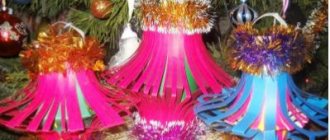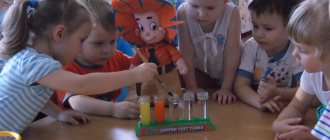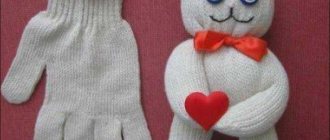Long-term planning for design and manual labor in the middle group. Target
Transcript
1 Subject Long-term planning FOR CONSTRUCTION AND MANUAL LABOR in the middle group p/p Educational topic Lesson topic Purpose Materials and equipment Literature “Goodbye, summer! Hello, kindergarten! “In the Land of Invention” “Forest kindergarten”. “Squirrel Gifts” September Learn to organize space for construction; plan activities, model; design various pieces of furniture; unite buildings with a single plot. Encourage the creation of new versions of already familiar buildings, develop design abilities, and form ideas about geometric shapes. To acquaint children with natural materials, with their properties (shape, surface texture), to interest children in the possibility of using it to create crafts. October Cubes. a box with construction materials, an envelope, flat paper models of various shapes, pencils, felt-tip pens. A toy or image of a squirrel, a basket, pine cones, acorns, nut shells, ash and maple wings, feathers, pebbles, twigs, plasticine, crafts made from natural materials, -26 VKT.2010, - p.79
2 “Visiting a fairy tale” “My favorite games” “Music box” “Castle for a princess” “Turtles” “Do-it-yourself Philharmonic” Develop children’s design skills, practice constructing strong buildings with ceilings by building paper models with bricks , making floors from plates and boards, constructing superstructures on floors, decorating roofs with various details; practice distinguishing and naming basic geometric shapes and shading. Develop imagination, creativity, the ability to independently perform a sequence of actions, generalize and compare. Teach children to divide plasticine into parts, practice orientation in space, strengthen the skills of rolling a ball from plasticine November Teach children to follow the construction plan, take into account color, shape, size. Colored pencils, building material, flat paper models of different sizes and colors. Finger game: "Turtle". Half of a walnut shell, plasticine, sample, stacks of building set - wooden, gnome toys, additional material - medical devices of material, -20 VKT.2010, - p.83 material, -13; Internet resources,
3 6. “We are one big family” “Bear” Develop an interest in manual labor, a desire to create crafts with your own hands. Encourage children to independently select material. December Plasticine, scales of cones, pits from plums or apricots, maple lionfish, watermelon seeds, a toy bear, a sample of crafts VKT.2010, - from “The Safe World of Childhood” “The Magical World of Books” “Houses, a shed and” “Mouse Rucker” Exercise children in fencing small spaces with bricks and plates installed vertically and horizontally; in the ability to make overlap; in mastering spatial concepts (in front, behind, below, above, left, right); in entertainment and naming colors. Develop independence in finding design methods; promote playful communication. Strengthen the ability to construct a craft from natural materials, teach how to choose materials for small parts, and navigate in space. January Felt-tip pens, construction kits. Reading a Russian folk tale: “The Little Mouse” Half a walnut shell, watermelon, pumpkin seeds, a piece of yarn, a thin twig, paper ear and tail blanks, glue, toy material, -21 VKT.2010, - p.86
4 “Active lifestyle” “Beauty will save the world” “How to work with these cubes and bricks” “Chicks on a green meadow” Give children the opportunity to independently become acquainted with cubes, bricks, prisms (distinguish the shapes, name them); lead to an understanding of the functional purpose of the material to build various structures. Learn to experiment and independently discover the structural properties of the material. Develop imagination. Encourage connecting and placing pieces in space in different ways. Cultivate interest in constructive activities. To consolidate the ability to design from pine cones, to introduce a new method of fastening (adhesive) parts made of this material to each other. February Tabletop building materials: cubes, bricks, prisms. (10 pieces of each type for 1 child) Listening to the song: “Chickens.” Music Vitaly Alekseev, words by Marina Frolova. Pine cones of different sizes, watermelon seeds, pumpkin seeds or small lionfish, paper blanks for eyes, plasticine, PVA glue, craft sample. material, -21; online resources VKT.2010, - p.94
5 Construction “Friendly guys” “I love you, Voronezh” “In the land of different words” “Animal houses” “Mushroom glade”. “Thirtieth Kingdom” Exercise children in fencing small spaces with bricks and plasticine. Develop independence in finding design methods, promote playful generalization. Learn to analyze a sample, transfer the knowledge and skills acquired in working with one material to the process of making crafts from another material. March Develop children's constructive skills; practice in the construction of durable buildings with overlapping buildings by lining paper models with bricks, making coverings from plates and boards. Constructing superstructures on floors, decorating roofs with various details. Develop imagination, creativity, the ability to independently perform a sequence of actions, generalize, compare. Felt pens, construction kits Half a walnut shell, plasticine, Squirrel toy, cardboard clearing stand Colored pencils, construction material. Flat paper models of different sizes and colors. material, -21 VKT.2010, - p.81 material, -28
6 “Healthy lifestyle” “In a world of different sounds” “Chickens are football players” “Trucks and cars” Strengthen the ability to design from pine cones. Introduce a new method of fastening (adhesive) parts made of this material to each other. Development of spatial orientation in children. April Give children a general idea of freight transport; exercise in its design, in analyzing samples, in transforming structures according to given conditions; give an idea of the construction part of the cylinder and its properties; clarify children’s ideas about geometric shapes; encourage the search for their own solutions, develop the ability for planar modeling. Pine cones of different sizes, watermelon, pumpkin or small lionfish seeds, PVA glue. Construction kits, scissors, brushes, glue VKT.2010, - p.94 material, “Week of Polite Sciences” “The Magic Forest of Lesovichka” Strengthen the ability to use natural materials to create crafts. Develop a sense of aesthetics. To develop an interest in manual labor and a desire to create crafts with your own hands. An image of the fairy-tale character Lesovichka, large fresh tree leaves, a large sheet of paper or thin cardboard. VKT.2010, - p.13
7 “The World Around Us” “Week of Whys” “Voronezh Bridges” “Why does the boat float?” 19. Pedagogical diagnostics May Give children an idea of bridges, their purpose, structure; practice building bridges; consolidate the ability to analyze examples of buildings and illustrations. Introduce children to a stencil ruler (with geometric shapes), practice working with it, comparing shapes, highlighting similarities and differences. Strengthen the ability to construct a craft from natural material by connecting a flying piece of plasticine Construction kits, stencil rulers, felt-tip pens. Photo of Voronezh bridges Half a walnut shell, a leaf of any tree, a paper flag, plasticine, glue, frog-frog (toy) material, -37 VKT.2010, - p.84 *Note: manual labor is carried out in the average flu 2 times per month (week after week) in free activity.
Labor card index
Card index: Household work in the middle group.
Card No. 1. “Order in the closet with toys and manuals”
Goal: to teach children to independently and aesthetically arrange toys and aids, maintain order in closets, and wipe dust. Develop hard work and the ability to see disorder. To cultivate aesthetic taste and the desire to work for the benefit of others.
Card No. 2. “Clean window sills”
Goal: to teach children to observe hygienic skills when working with water: roll up their sleeves, wet a cloth and wring it dry, rinse when dirty. Develop labor skills and habits, accuracy when working with water. Cultivate a desire to work in a team, in harmony.
Card No. 3. “Helping the nanny”
Goal: To teach how to make bed linen and to teach children to provide all possible assistance to adults. Develop hard work and a desire to help adults. Foster respect for the work of adults.
Card No. 4. “Canteen duty”
Goal: independently and conscientiously perform the duties of a duty officer; wash your hands thoroughly, put on the clothes of the person on duty, set the table correctly, remove the dishes after eating; brush off tables and sweep the floor. Develop labor skills and abilities, the ability to see disorder in the table setting. Cultivate a desire to work for the benefit of others.
Card No. 5. “Class duty”
Goal: independently and conscientiously perform the duties of an attendant: lay out materials and aids prepared by the teacher for the lesson on tables; wash and put them away after class. Develop hard work and a desire to help adults. Cultivate a desire to work for the benefit of others.
Card No. 6. “Order in toys”
Goal: to teach children to put on work aprons before starting work; keep toys in order: wash, dry, wipe and put in place. Develop hard work and the ability to see disorder; be careful when working with water. Cultivate a desire to work for the benefit of others.
Card index: Labor in nature in the middle group.
Card No. 1. Watering indoor plants. Goal: Teach children to care for indoor plants; water
from a watering can with water at room temperature; consolidate children's knowledge about different methods of watering indoor plants. Develop accuracy when working with water and plants, confidence in your actions, work skills. Foster a caring attitude towards the natural environment and a desire to take care of it.
Card No. 2. Loosening the soil of indoor plants.
Goal: Teach children to care for indoor plants; give children knowledge about why it is necessary to loosen the soil of plants; consolidate loosening techniques and rules for using the necessary items for this. Develop labor skills, accuracy. Foster an ecological culture and respect for the environment.
Card No. 3. Spraying indoor plants.
Goal: To teach children to provide all possible assistance to the teacher in caring for indoor flowers: spray the plants with water at room temperature, use the sprayer correctly. Develop labor skills and habits, accuracy when working with water and plants. Foster an ecological culture, a caring attitude towards the natural environment, and a desire to take care of it.
Card No. 4. Caring for large-leaved plants (wet wiping of leaves).
Goal: To teach children to provide all possible assistance to the teacher in caring for indoor flowers: wipe large leaves of plants with a damp cloth, being careful. Give children the knowledge that this method of care makes it easier for plants to breathe, which determines their growth and development. Develop labor skills and habits, accuracy when working with water and plants. Foster an ecological culture, a caring attitude towards the natural environment, and a desire to take care of it.
Card No. 5. Caring for plant leaves (removing dust with brushes and a dry cloth)
Goal: To teach children to provide all possible assistance to the teacher in caring for indoor flowers: remove dust from plants with brushes or dry cloths, being careful. Give children the knowledge that this method of care makes it easier for plants to breathe, which determines their growth and development, and improves their appearance. Develop labor skills and habits, accuracy when working with water and plants. Foster an ecological culture, a caring attitude towards the natural environment, and a desire to take care of it.
Card No. 6. Plant cuttings.
Goal: To clarify children’s knowledge of what a plant can be grown from.
Teach children how to properly plant a plant cutting, prepare the soil, care for them and the sequence of work: pour sand into the bottom of the pot, then soil, water, wait until the water is absorbed into the sand, make a hole in the middle (center) of the pot with a stick and plant the cutting until the first leaf, press the ground. Water as needed. Develop labor skills and habits, accuracy when working with water and plants. Foster an ecological culture, a caring attitude towards the natural environment, and a desire to take care of it.
Card index of manual labor Construction in the middle group
.
“Design according to your own plan” “Perestroika”.
Goal: to encourage children to rebuild this or that building (arrange, expand, extend...) creating a play situation. Progress: the children built a gate on their own initiative; the teacher takes a car (obviously larger than the gate), puts a toy in it, drives up to the building and says, “You open the gate and let the car through!” Thus, he encourages children to rebuild the building so that the car can pass.
“Designing according to your own design.” "Guess where I am?"
Goal: to consolidate the ability to navigate the space of a building (on, behind, under, around, in...). Progress: the children built various structures of their own free will; The teacher takes any toy (cockerel) and starts the game: The cockerel flies up to the roof, hides in the house, climbs under a bench, sits on a fence, etc. and asks: “Where am I?” The children answer.
“Design based on the fairy tale “The Three Bears”.”
Constructive activity "Forest kindergarten". Goal: improve the ability to design a house plan, encourage initiative (opening doors, pieces of furniture...), independence. Progress: after talking with the children about why they love kindergarten, the teacher leads them to the idea of building the same ones for the animals
“Graphic replacement of parts” “Select figures.”
Goal: to consolidate children’s knowledge about geometric shapes and the ability to build images from them that are similar to real ones. Procedure: the teacher puts a tray with geom in front of the children. pieces, and offers to divide them equally (“Sasha took a yellow square, and you all take the same piece”). At the end of the work, each child puts the selected figures in his own envelope. Then the children make images from the figures that are similar to real ones. They beat them.
“Replacement with building parts and their simplest combinations of game characters” “Transformations of figures.”
Goal: to strengthen children’s ability to find similarities between geometric shapes and children’s favorite characters; transform any figure into an image using drawing. Procedure: the teacher invites the children to trace geometric shapes and turn them into any images, drawing on the details with felt-tip pens. Encourage the combination of figures, interesting creative finds.
“Designing according to children’s ideas” Constructive activities
Goal: continue to teach children the main stages of developing a building plan, independent planning of activities; the ability to solve riddles. Procedure: the teacher asks the children riddles, and asks them to figure out the answers themselves. (1) Early in the morning, at dawn, a tower rose on the mountain. With golden domes and painted walls. /church/; 2) paths lead us across rivers and ponds, we walk boldly along them without getting our feet wet. /bridge/; 3) a white bird rushes across the sky, dances in the clouds, but does not flap its wings /plane/; 4) doo-doo-doo! I'm walking along the rails./train/; 5) a blue.../truck/ is rushing straight down the road.
Card index: Self-service in the middle group.
"Nutrition"
Goal: To improve the ability to hold a fork with the thumb and middle finger, holding it on top with the index finger, eat different types of food without changing the position of the fork in the hand, but only slightly turning the hand.
Course: Conversation “Let’s remember how to eat properly.” Reading: N. Litvinova “The Kingdom of Cutlery”
"Dressing - Undressing"
Goal: Improve the ability to dress and undress independently in a certain sequence, correctly place your things in the closet, and fold them neatly.
Progress: Conversation “Every thing has its place.” Reading: I. Bursov “Galoshes”, S. Mikhalkov “I myself.” Didactic exercise: hang clothes on a chair before going to bed. Strengthen the ability to use different types of fasteners “Who can fold clothes correctly and quickly”
"Washing"
Goal: Improve washing skills: soap your hands until foam forms, rinse thoroughly, wash, wipe your face and hands dry with a towel, use a handkerchief in a timely manner.
Progress: Reading: I. Ishchuk “My palms.” Didactic exercise “Let’s tell the kids how to wash themselves”
"Making the Bed"
Goal: To consolidate the ability to make a bed: straighten the sheet, cover it with a blanket.
Progress: Didactic exercise “How to make a bed”
“Keeping clothes and shoes in order”
Goal: Continue to learn how to dry and clean your clothes, wash, wipe, and clean your shoes. Strengthen the ability to sew torn buttons.
Course: Conversation “How to take care of your clothes.”





